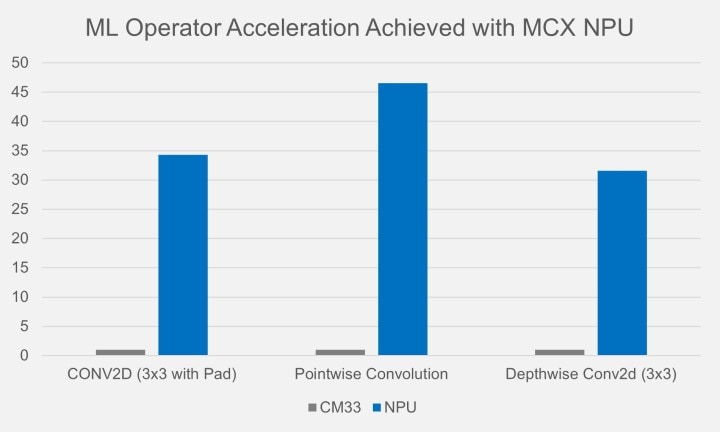Coinciding with the expansion of IoT, another mass migration is underway.
Intelligence is shifting from the cloud to edge devices capable of machine
learning (ML) and able to process streams of sensor data locally with lower
latency, greater security and more user privacy than cloud-based AI systems.
To convert edge data into actionable edge intelligence, developers require a
new class of low-power microcontrollers (MCUs) with multicore performance and
built-in accelerators for ML tasks while minimizing power budgets to maintain
energy-efficient system designs.
Looking to the future of MCUs for edge intelligence, NXP recently launched the
MCX portfolio, an MCU platform that delivers scalable performance, parallelism, security,
power efficiency and a rich peripheral set optimized for an array of IoT,
edge ML and industrial use cases. The MCX portfolio combines the DNA of NXP’s
LPC and Kinetis MCU families to redefine the next generation
of general-purpose MCUs for smart, connected devices.
The first MCX offering out of the gate is the MCX N Advanced series, designed
for secure, intelligent edge applications. The N series includes the newly
announced
MCX N94x and MCX N54x MCU families
featuring a highly efficient multicore architecture, an integrated
EdgeLock® secure subsystem and a dedicated, on-chip neural
processing unit (NPU) for real-time inference. The MCX N94x family is geared
toward industrial applications with a wider set of analog and motor control
peripherals, while the MCX N54x family targets consumer and IoT applications
with peripherals ranging from high-speed USB with a PHY to secure digital (SD)
and smart card interfaces.
What can you do with a 150 MHz MCU?
Delivering multitasking performance and advanced neural networking and ML
capabilities with a low-power 150 MHz MCU may seem extraordinarily difficult, but the MCX N94x and MCX N54x devices are not ordinary MCUs. They are marvels
of multicore design and peripheral integration.
The MCX N94x and MCX N54x are based on dual high-performance Arm®
Cortex®-M33 cores running up to 150 MHz, along with 2MB of
flash with optional full ECC RAM, smart DMA, a DSP co-processor, a secure
subsystem and an integrated NXP-designed NPU. Developers can use any
combination of these cores and accelerators for specific tasks without driving
up the MCU clock speed or increasing power consumption.
 MCX N94x Block Diagram
MCX N94x Block Diagram
To better experience, download the
block diagram.
The on-chip accelerators enable the MCX N MCUs to juggle multiple complex
tasks very efficiently within a low power budget while keeping the system
secure. The multicore design delivers improved system performance and reduced
power consumption by enabling smart, efficient distribution of workloads to
the analog and digital peripherals. As a result, the MCUs consume less than 45
μA/MHz active current, less than 2.5 μA in power down mode with the real-time
clock (RTC) enabled and 8 KB SRAM retention, and less than 1 μA in deep
power-down mode with the RTC active and 8 KB SRAM.
The dual-core architecture pairs a full-featured Cortex-M33 core with a
streamlined M33 core to manage control functions, enabling developers to run
applications in parallel or reduce overall power consumption by turning off
individual cores as needed. For example, during secure over-the-air (OTA)
updates for IoT devices, the main M33 core can handle system security, while
the second streamlined core executes control functionality.
The MCX N MCUs include NXP’s first instantiation of its specialized NPU
designed to enable high-performance, low-power intelligence at the edge. The
on-chip NPU delivers up to 30x faster ML throughput compared to using a CPU
core alone.
 NPU Relative Acceleration
NPU Relative Acceleration
This top of MCU class ML performance expands TinyML capabilities for resource-
and power-constrained edge devices. Imagine the possibilities: you can
implement sophisticated deep-learning models, add face and voice recognition
for access control, create battery-powered glass-break detectors for home
security systems, develop vibration sensors for motor control predictive
maintenance and design smart wearable devices equipped with bio sensors.
Flexible and Secure by Design
The MCX N Series peripheral flexibility is like a developer’s treasure box.
The high-resolution mixed-signal analog peripherals are designed to operate
with greater autonomy to minimize CPU interrupts and save power. For example,
the ADCs have built-in intelligence to continually collect data and average
the stored data locally. Each of the MCUs’ two 16-bit ADCs can be used as two
single-end input ADCs (effectively functioning as four ADCs) or as a single
differential input ADC.
Industrial-strength communications peripherals include Ethernet, CAN-FD,
BLDC/PMSM motor control support, high-speed and full-speed USB, and integrated
sensor interfaces (MIPI-I3C, I2C, UART and SPI). For added flexibility, NXP’s
LP Flexcomm interface allows any combination of ten serial peripherals
including SPI, UART and I2C.
Built following NXP’s secure-by-design approach, the MCX N series MCUs feature
an EdgeLock® secure subsystem having a secure boot with an
immutable root-of-trust, hardware-accelerated cryptography, active and passive
intrusion detection plus voltage and temperature tamper detection. This
best-in-class security architecture provides support for in-field updates,
online transactions and protection against over-production at remote original
design manufacturers (ODMs).
Getting Started with MCUXpresso and eIQ® Software
To help ease and accelerate system development, the MCX N MCUs are supported
by NXP’s popular
MCUXpresso
suite of software including tools for simple device configuration and secure
programming. Developers can choose to use the fully featured MCUXpresso IDE or
IDEs from IAR and Keil. NXP provides drivers and middleware with extensive
examples and support for a range of RTOS choices, complemented by a wide array
of compatible middleware from NXP’s partner ecosystem, enabling rapid
development of a broad range of applications. NXP’s eIQ® ML
software development environment also provides easy-to-use tools to train and
support ML models running on the integrated NPU.
Connect with MCX N
MCX N opens new possibilities for advanced edge ML designs with limited power
budgets. Learn more about the NXP
MCX N94x and MCX N54 MCUs.





